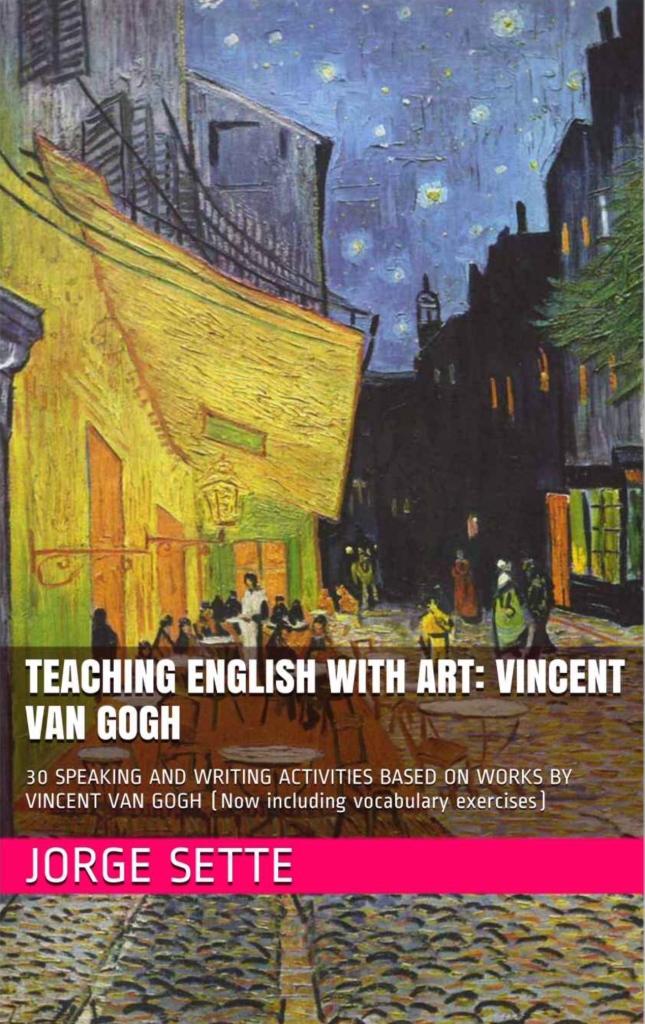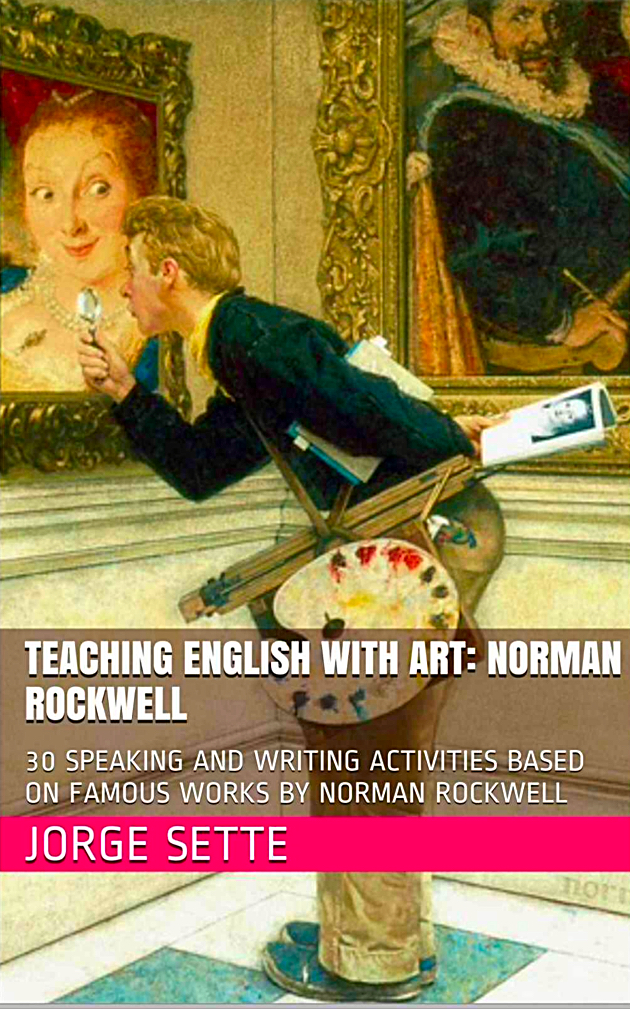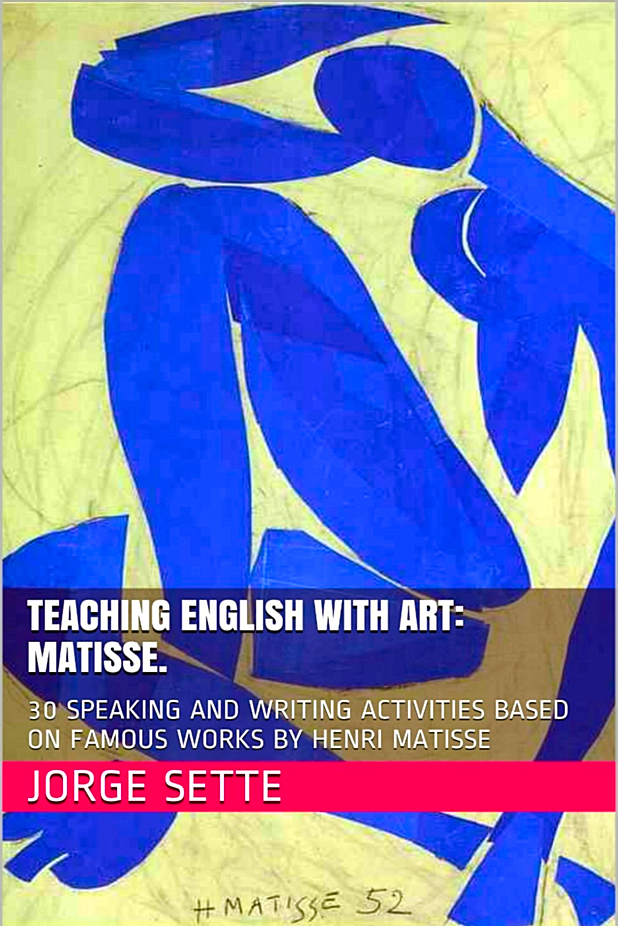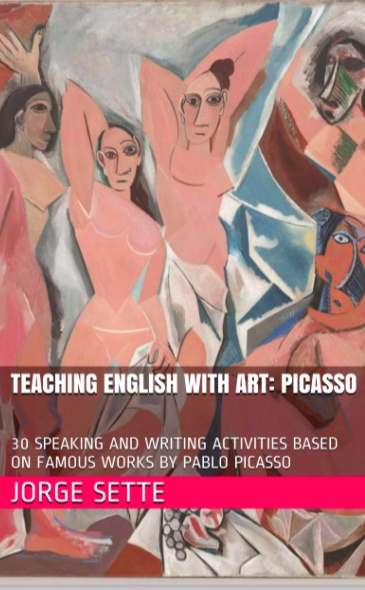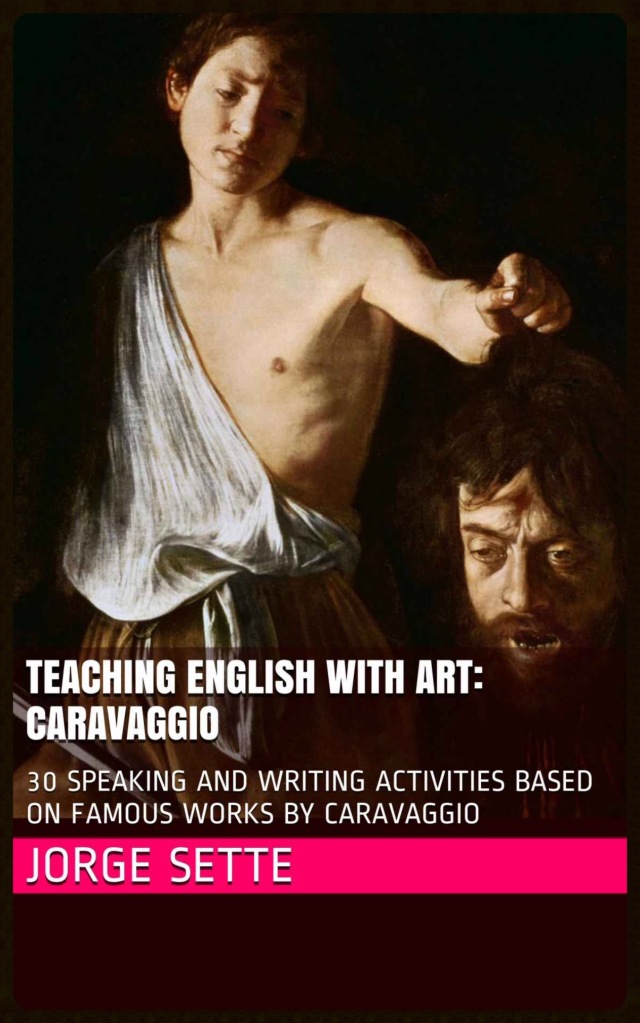Tag Archives: cubism
English Teaching Should Go Beyond Language!
Sample activities from the eBook TEACHING ENGLISH WITH ART: PICASSO
Image 2: Acrobat on a Ball. 1905
Activity 4: speaking. Level A1/A2
- Describe the picture. What’s the predominant color?
- This is a painting from Picasso’s Rose Period (1904-1906). Everything is kind of pinkish. How was Picasso feeling during this period? Why do you think so?
- What does the color pink remind you of?
- Who are those people? What’s their relationship? Where do they work?
- The girl can stand on a ball. This is difficult to do. What else do you think she can do? Can you do anything difficult? What?
Activity 5: speaking. Level A2
- What’s this girl like? Tell us about her personality. What about the man?
- Describe the girl physically. Now describe the man.
- What do you think she likes doing in her free time? What do you like doing in your free time?
- Do you like the circus? What do you usually see in the circus?
- Pair work: students are divided into A and B. Student A lists the positive points of a circus. Student B disagrees and says why.
- Make a poster of a circus (a drawing or a collage or both) and present it to the class.
Activity 6: writing. Level B1/B2
- Write a composition imagining what your life would be like if you worked for a circus. Tell us about your job. What you usually do. The different kinds of people you work with. Do your relatives work there too? Who? (Do some research on the Internet to find out what kind of life circus people live. Use your own words in the composition. 400 – 700 words).
- Read your partner’s composition. Help her correct some mistakes and ask questions to help her write a more complete and better composition. Then ask her to help you with yours.
For more info about the series TEACHING ENGLISH WITH ART: Click on the link below to go to AMAZON.COM and get your ebooks: http://wp.me/p4gEKJ-1lS

Click on the image above to access the KINDLE STORE. Teaching English with Art: Matisse, Picasso, Caravaggio, Monet, Norman Rockwell
Au revoir Jorge Sette
Teaching English with Art (video)
Teaching English with Art: the ENGLISH LANGUAGE LEARNING materials you have been waiting for:
TEACHING ENGLISH WITH ART: MATISSE. Click here for more info: http://wp.me/p4gEKJ-1kP
TEACHING ENGLISH WITH ART: PICASSO. Click here for more info: http://wp.me/p4gEKJ-1lA
#matisse #picasso #fauvism #cubism #moma #tate #teachingenglish #language #learningenglish
Teaching English with Art: make your online lessons stand out
Ideal for online lessons!!
If you are having any of the following problems, we can help you…
a. Are your students often bored during the English class? b. Don’t they know what to say when you set up speaking activities? c. Do you spend the weekend correcting writing assignments that don’t seem to help them improve? d. Is it hard to personalize productive skills and link the English lesson to the other subjects in the school curriculum? e. The students know nothing about Art and high culture in general.
Click on each of the pictures below to get your copy from the KINDLE STORE:
Teaching English with Art is the series for you! This eBook series is a wonderful supplement to any coursebook or extra materials your students may already be using in the English class. Each volume contains 30 speaking and writing activities for classroom use based on some of the most striking works by famous artists: for now we have MATISSE, PICASSO, CARAVAGGIO, MONET, NORMAN ROCKWELL, WINSLOW HOMER, a special three-in-one volume of MONET + PICASSO + MATISSE (90 activities), and we’ve just launched VAN GOGH.
IMPORTANT NOTE:
PERSONALIZATION: if you wish to change the cover of any of the ebooks, add your school logo, negotiate a special price for a determined number of students, or make other suggestions of customization, do not hesitate to talk to us. We are VERY FLEXIBLE. Make your ebook UNIQUE!
The objective of these eBooks is to expose the students to high art while having them practice English, fulfilling, therefore, one of the tenets of effective language acquisition: providing a realistic context for the language to be learned and practiced as a means to an end. Your students will love to practice their English discussing and doing writing tasks based on the works of these great artists. The activities are highly personalized, so the students can express their own opinions and feelings. This is a proven way to make language acquisition fun and effective by creating in the classroom an atmosphere of interest, motivation and personalization. Each activity is clearly correlated to the COMMON EUROPEAN FRAMEWORK OF REFERENCE (CEFR), and the level is stated next to it. Ideally both you and your students should purchase the material. For heads up activities, project the images on a white wall. Chose your favorite artist and click on the corresponding image below to go to AMAZON.COM and get your e-book:
If you need more instructions on how to purchase the eBooks, please click here: http://wp.me/p4gEKJ-1Cz
Jorge Sette.
Teaching English with Art: Picasso
Click on the image below to download your book FROM AMAZON.COM
You will never have bored students again.
For other eBooks of the series TEACHING ENGLISH WITH ART, please click here:
Check out the video clip on our eBooks below:
Au revoir
Jorge Sette
Cubism: the most revolutionary art movement of the 20th century
Pioneered by Pablo Picasso and Georges Braque, Cubism is one of the most revolutionary and seminal art movements of the 20th century. It has its origins in the post-impressionist paintings of Paul Cezanne, and aims at depicting reality in a non-naturalistic way, being considered the seed of the abstract paintings developed later on. Cubism in its more innovative and radical form lasted from 1907 to 1914, when the First World War broke out.
The end of the 19th century and the early decades of the 20th century were marked by great technological innovations that cried for an art form that could express these fast changes and new times. Traditional art, based on realistic works, which had been perfecting the use of perspective since the Renaissance, could not compete with the innovations of photography and film. They would be a mere replication of these more accurate methods of showing reality.
In an attempt to grasp the essence of the times, Picasso started to move towards more simplified depictions of objects and the human form, trying to represent simultaneously the different angles from which they could be seen, not only from a unique perspective. He started to flatten his images, making use of geometric shapes (such as cubes, hence the name of the movement) and deconstructing reality by slashing the image into different planes, producing, thus, an effect which had a more intellectual than sensorial impact on the viewer.
The iconic painting Les Demoiselles d’Avignon is considered the first Cubist work of art. Primitive art, such as African masks and Iberian sculptures, played an influential role in the development of Cubism. This first phase of the movement is usually known as analytic cubism, characterized by the use of dark, almost monochromatic color hues, and growing to a point where the deconstruction of reality became so radical that the viewer could hardly identify the object or person depicted. The second phase, synthetic cubism, was a lot more energetic and colorful, including the technique of collage, where real-life two-dimensional materials, such as colored paper, newspapers or even hair ribbons, were glued to the painting.
It’s hard to pinpoint when Cubism really finished, although we usually place it in the historical period between 1907-1914. It actually did not end, but transformed itself and evolved into other styles in the following decades.
Even today we can identify strong influences of Cubism in architecture, design and, of course, the arts in general.
NOTE: If you teach languages, you might want to check out our series of eBooks TEACHING ENGLISH WITH ENGLISH available from AMAZON.COM: http://wp.me/p4gEKJ-1lS
Au revoir
Jorge Sette
Les Demoiselles d’Avignon: disturbing, shocking…mesmerizing!
Considered by many the quintessential painting of the 20th century, the first radical rupture with the aesthetics of the 19th century and all the previous western art in general, this iconic painting still has the power to mesmerize, disturb and even shock visitors to the MOMA in New York, where it’s been housed since the late 1930s.
The influences this enigmatic painting incorporate range from Iberian art, African masks, photographs of African tribes, and, mainly, the sheer raw inspiration of Picasso’s wild imagination, who probably projected a mixture of images, feelings and contradictions fished from the depths of his psyche onto the canvas. Access to the artist’s notebooks and sketches after his death in 1973 has shown that Picasso underwent serious preparation for this work. There are 700 sketches of what would become The Demoiselles before it finally came to light. Such painstaking preparation seems to be a unique feat in the history of western art. No other known artist has ever gone to such lengths to prepare for a piece.
Supposedly representing prostitutes in a brothel, the painting goes way beyond this interpretation, defying the concept of narrative or even of interpretation itself. It could be a deconstruction of many previous nudes in western art, taken apart and rebuilt in a total original and contemporary way. Rumor has it that Fernande Olivier, Picasso’s mistress of the time, could be the inspiration behind the faces of all of the women in the painting. Her response to the piece, when she first saw it, was a disconcerting silence, which can only me interpreted as profound disgust and hatred.
Fernande’s reaction was not very different from anyone else’s at the time it was painted – 1907. The work was kept hidden in Picasso’s studio for years and was only seen occasionally by his friends and critics. Despite the fact that Les Demoiselles had partially been inspired by Matisse’s revolutionary The Joy of Life, his reaction was very negative. He thought Les Demoiselles was a mockery of all they were trying to accomplish in terms of Modern Art at the beginning of the century. And he threatened to get back at Picasso for his insult. The work was only exhibited publicly 9 years after its creation: Picasso himself needed all this time to sum up the courage and strength to face the bombardment of criticism he knew it would generate.
Even viewers today sometimes complain of the aggressiveness of the work, whose characters seem to stare down at them with weird unpaired eyes in an attitude of contempt and superiority.
Despite all the controversy, however, the fact is most of us have grown accustomed to Picasso’s style – or rather styles – over the years, and the painting is the jewel of the MOMA, loved and treasured by most visitors.
NOTE: You might want to check out our eBooks available from AMAZON.COM: http://wp.me/p4gEKJ-1lS
Au revoir
Jorge Sette
Pablo Picasso: a revolution in the visual arts
The key words to define the creative output of Picasso, one of the most famous artists in history – and whose art involves not only paintings, but drawings, sculptures, collages and pottery – are, among others: cubist, revolutionary, shocking, free, provocative, sinful, decadent, unique, striking, wonderful. Ahead of its time, as the work of most great artistic minds, it took time for his more innovative art to be understood and appreciated by the general public.
Picasso has become a brand. The influence of his work has gone way beyond art to touch the fashion industry, the automobile industry, architecture and design in all corners of the world for the last 70 years or so. Together with his close friend and rival, Matisse, Picasso is considered the greatest artist of the 20th century.
The art of Picasso and Matisse were always in constant dialogue. They were always paying close attention to each other’s developing work, copying and referencing motifs and vocabulary to advance their own pieces. However, this copying was always subject to a digestive process, where the opponent’s innovations and techniques were appropriated and personalized, coming out as distinctive and original manifestations, when they finally showed up in the rival’s work.
Unlike Matisse, however, whose work does not spell out clearly its relation with his personal life, Picasso’s works reflect a life well lived: his passions, his womanizing, his contradictions, his lovers, his wives, his friends, his loneliness, his unorthodox and bohemian life style are all reflected in his art.
If he chose, Picasso could easily paint and draw in a more classic way, in the vein of the masters of more traditional art, as his early works attest. However, he thought that, in an age in which photography and film took over the job of representing reality as it is, the objective of the artist was to push the envelop, going way beyond the mere copying of the world as one sees it. Besides, Picasso had a very clear notion of the arbitrariness of the various signs of representation from his own life experience: he was a Spanish national who lived in France for most of his life without ever dominating completely the local language. It’s speculated that this factor played a huge role in his liberation from rigid patterns of realistic representation of the external world.
By working mainly at night and usually painting directly from his imagination, without models, Picasso struggled and succeeded in exploring the inner life of things and people. He expressed in his work the way he felt about people, he let their personalities and attitudes manifest themselves through his masterpieces. He distorted and played with the objects of everyday life to make them convey aspects we are not used to noticing. He depicted reality in totally new ways by mixing styles, flattening perspectives, and thus confounding and broadening the viewer’s perception, painting the same scene as seen simultaneously from different angles.
But his work goes way beyond the mere exploration of his personal life and the attempt to exorcise his inner demons. He grew to express the whole dark atmosphere of the 20th century, the bloodiest period in human history, in some of his most violent and impactful productions – such as the painting Guernica, which conveys, in horrific and stylized detail, the violence of war and its effects on innocent people.
The lasting influence of this great artist will still be felt in many years to come.
NOTE: You might want to check out our eBooks series available from AMAZON.COM, TEACHING ENGLISH WITH ART, please click here: http://wp.me/p4gEKJ-1lS
Au revoir
Jorge Sette
Matisse and Picasso: a competitive and productive conversation
“Art is a lie that makes us realize truth, at least the truth that is given us to understand. The artist must know the manner whereby to convince others of the truthfulness of his lies.” Pablo Picasso
Matisse and Picasso, two of the greatest masters of the 20th century visual arts, were introduced to each other by Gertrude Stein, an American intellectual and writer whose family moved to Paris. Her family became also one of the main patrons of both artists, although, as time went by, Gertrude seemed to favor Picasso’s work over Matisse’s.
From the beginning, both men always had a competitive relationship with each other. This competitiveness, however, proved very productive, as their work, at each stage, was often a response to the other’s more recent painting or change in style. The exposure to the competitor’s latest work usually goaded each of them not only to incorporate some new and intriguing element just discovered by his opponent but to surpass it or give it a more personal angle.
In a grossly simplified way, we can say that Matisse’s paintings were more cerebral, carefully planned, based on a representation of living models, despite all the distortions and changes to which this model may be subjected on the canvas, whereas Picasso’s work was more visceral, entirely produced from his imagination alone, without the need of a reference in the real world. Matisse painted in daytime, he had a family and was a quiet and sensible man. Picasso, on the other hand, was the stereotypical passionate bohemian artist, living in poor and disheveled quarters with his mistress of the moment. He painted at night. Matisse was French; Picasso, Spanish.
Matisse was the master of vibrant colors, ornament and light. His lifeline was the arabesque. His art style was part of Fauvism (from the word fauve, which means wild beast in French), a movement considered the natural continuation of Impressionism, with a direct influence from the painter Cezanne. Picasso was the master of fragmentation, radical abstraction and the use of varied and intersecting geometric planes slicing the image on the canvas. His paintings were a lot darker and more aggressive than his colleague’s. These features were the essence of Cubism, a movement that consisted of deconstructing the human form in the painting by replacing it with geometric ones, mainly cubes, assembled together in a way that barely resembled the original idea when finalized. Cubism also had no problem incorporating in the same painting the vocabulary and technique of other styles, composing a complex and mesmerizing whole. This was probably a reflex of Picasso’s personal life, a foreign in France, who could never express himself fluently in the language of his adopted country, therefore becoming very aware of the arbitrariness of the different codes of representation, language and painting included.
Neither Matisse or Picasso thought that the aim of art was to represent a naturalistic view of the external world. Photograph could do that. The important thing was to apply the “Instagram” filter of emotion and personal experience to it. Hence the progressive abstraction of their works.
Matisse was 12 years older than Picasso, but, as their parallel artistic lives developed, they became the closest friends. Each understood the richness and breakthrough quality of the other’s new paintings and variations in style long before anyone else. Their respect and influence was mutual: their conversation lasted a lifetime.
After Matisse’s death, Picasso missed his friend’s feedback and, sometimes provocative reaction to his own paintings, so deeply that he incorporated obvious references to Matisse’s art into his own work, so the dialogue could carry on intrinsically, within the painting itself.
For me the works of these two artists can only be described as breathtaking. Matisse’s paintings have a soothing and relaxing effect on my life. I revert to Picasso’s whenever I feel the need to nurture my darker side and infuse my days with a boost of passion.
NOTE: You might want to check out our eBooks series TEACHING ENGLISH WITH ART, available from AMAZON.COM. Clique here for more info: http://wp.me/p4gEKJ-1lS
Au revoir/Saludos
Jorge Sette




